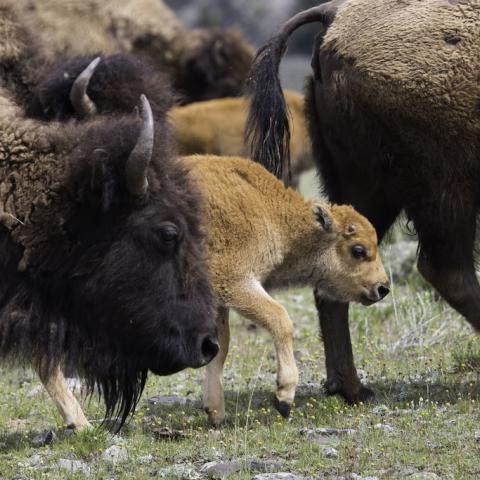Getting too close to full-grown bison and trying to "save" newborn bison calves from the cold are some of the illegal and downright dangerous and inappropriate behaviors visitors to Yellowstone National Park have taken in recent weeks, prompting park officials to warn all visitors to behave appropriately in the park.
In the case of the bison calf, which two visitors placed inside their SUV recently because they thought it was cold, park rangers later had to put down the animal because it was abandoned by its mother and "was continually approaching visitors and vehicles."
In a release Monday morning park officials urged visitors to respect the fact that the park's animals are wild and should be viewed from a distance.
In the case of the two unidentified visitors who placed the newborn bison calf in their vehicle, rangers cited them for "their misplaced concern for the animal's welfare."
"In terms of human safety, this was a dangerous activity because adult animals are very protective of their young and will act aggressively to defend them. In addition, interference by people can cause mothers to reject their offspring," the release said. "In this case, park rangers tried repeatedly to reunite the newborn bison calf with the herd. These efforts failed. The bison calf was later euthanized because it was abandoned and causing a dangerous situation by continually approaching people and cars along the roadway."
In the weeks prior to that there was a video of a visitor who "approached within an arm's length of an adult bison in the Old Faithful area. Another video featured visitors posing for pictures with bison at extremely unsafe and illegal distances. Last year, five visitors were seriously injured when they approached bison too closely. Bison injure more visitors to Yellowstone than any other animal," the release went on.
Approaching wild animals can drastically affect their well-being and, in this case, their survival. Park regulations require that you stay at least 25 yards (23 m) away from all wildlife (including bison, elk and deer) and at least 100 yards (91 m) away from bears and wolves. Disregarding these regulations can result in fines, injury, and even death. The safety of these animals, as well as human safety, depends on everyone using good judgment and following these simple rules.




 Support Essential Coverage of Essential Places
Support Essential Coverage of Essential Places







Comments
I worked in the park 32 years ago. These National Parks are amazing and are greatfully shared. we have all diferent kinds of people who come to our parks. If you don't understand the enviroment then stay home!
I think everyone entering the park should be advised of the rules in writing (in whatever their language) prior to entry and the rangers should have the authority to issue large fines for violations and also remove people from the park.
A few yrs. ago at Yellowstone on a guided nature trip, we were having our picnic dinner, and witnessed a herd of bison with several baby bison crossing the roadway. Then a car stopped, a woman jumped out with her camera, and proceeded to get between a baby and its mother. Unbelievable. People yelled to the woman, but she was more interested in taking her pictures. Finally, this idiot got back into her car, and the bison herd moved on. On another trip, during a fall nature trip, we watched a woman approaching a male elk - during mating season. It does no good to warn people of the dangers of approaching wild life. Some people are just stupid.
What these tourist did to that poor calf was stupid and misguided. But I don't understand why the calf had to be euthanized. Isn't there an animal sanctuary that could have taken this poor baby?
Visitors get multiple warnings when the enter the park and all throughout the park. Warnings are literally all over. These come in many different languages and are full of illustrations in case anyone can't or doesnt take the time to read. I agree, fines should be huge!
The calf had to be euthanized because it could not be quarantined and cared for for the length of time necessary to then give it to a sanctuary. Brucellosis exists in the park and state and federal laws require quarantining of all animals that could be carriers. Transporting the calf without quarantine would break several laws and possibly infect domestic herds. The Rangers risked their lives to get the calf back to its mother. The choice to euthanize should be blamed on the idiots who put it in their vehicle not the Park Service!
I think it is time to issue every park ranger a hammer and a set of nails. Anytime someone is found trying to take a selfie or otherwise too close to wildlife, the phone/camera is smashed with the hammer and nailed to a board near the entrance or visitor center with a sign that says, "This is what happens to Violators!!!", in every language possible, of course. The possibility of fines are not going to stop most people with skulls full of stupid. They need an example of instant anti-gratification.
It wasnt' the bison calf that needed to be euthanized...